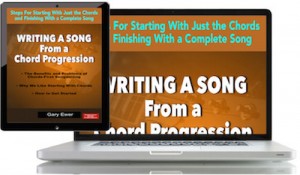Whatever you write about comes with a mood. Not to simplify this, but songs are usually either generally happy or sad, with often a blend of many different shadings of emotions. “Happy” can mean “triumphant”, “at peace”, “jubilant”, “satisfied”… you get my meaning.
Of all the various elements that go together to make a song, chord progressions are ones that people feel convey basic moods the best, though this is usually based on stereotypes that are rarely accurate. For example, the notion that “major” means happy and “minor” means sad is often not true when you examine the lyric that goes along with those chords.
 If you like starting songs by working out a good chord progression, you need to get “Writing a Song From a Chord Progression.” It shows you the strengths and pitfalls of this very common songwriting process.
If you like starting songs by working out a good chord progression, you need to get “Writing a Song From a Chord Progression.” It shows you the strengths and pitfalls of this very common songwriting process.
As a song progresses, moods will change practically line by line. And this is where all the many components of a song — chords, melodic shape, lyrics, instrumentation and so on — need to help support those changes of mood.
As you write your songs, here’s a short list of things you can think about, things that have to potential to enhance the mood of your music. Keep in mind that these ideas depend on partnership with other ideas, and so you really need to experiment to determine their full effect:
- Direction of the bass line. Descending bass lines might magnify a song’s melancholy mood, while rising bass lines may go hand-in-hand with a lyric’s strengthening of resolve, or sense of determination.
- Presence of a melodic leap. If your song’s lyric is about some aspect of love, a melodic leap — where the melody leaps up (or occasionally down) several letter names — can help to enhance and stimulate an emotional response from your audience. (“Somewhere Over the Rainbow” is a famous example of a rising leap, while the start of the chorus of “Man in the Mirror” (Siedah Garrett and Glen Ballard) is a good example of a descending leap.
- Tempo. Slowing a tempo down can help a song sound more introspective and thoughtful, while speed it up can bring out more of a sense of resolve and determination. Tempo is something very much worth experimenting with, as the resulting emotional enhancements can change quite radically.
- Key and melodic range. If you think of key more as a way of determining how high the voice will be, key can be a powerful determiner of how much of whatever mood comes forward. As a melody moves higher, a natural kind of vocal tension (perhaps even strain) will allow certain emotions to build that might otherwise not come into play. Think of the chorus of “Free Fallin'” (Tom Petty, Jeff Lynne) as a great example of what melodic range can do. The chorus is the same as the verse, but an octave higher.
- Instrumental technique. Guitarists know the difference in sound that comes from the many different ways you can play the instrument: strumming versus finger picking, for example. The thickness of the instrumental texture (i.e., how many instruments are playing), how loudly they play, their basic playing range, etc., all have ways of enhancing certain moods. This is something that can and should be thought about at the production stage of songwriting.
Successful songwriting means creating powerful partnerships between various song components, and good songwriters already know this. But hopefully the ideas above will help to show that any one element within a song can be enhanced or stifled by other factors such as tempo, key, melodic structure, etc. Once you’ve written your song, the ideas above are the kind of things that you can and should experiment with.
 Written by Gary Ewer. Follow Gary on Twitter.
Written by Gary Ewer. Follow Gary on Twitter.
 Get “The Essential Secrets of Songwriting” eBooks. They’ll help you polish your technique, and make you the best songwriter you can be. Comes with a Study Guide, tons of chord progressions, and information covering every aspect of how to write good music.
Get “The Essential Secrets of Songwriting” eBooks. They’ll help you polish your technique, and make you the best songwriter you can be. Comes with a Study Guide, tons of chord progressions, and information covering every aspect of how to write good music.











Pingback: How to Power Up and Control the Mood of Your Music - The Hit Songwriting Formula | The Hit Songwriting Formula